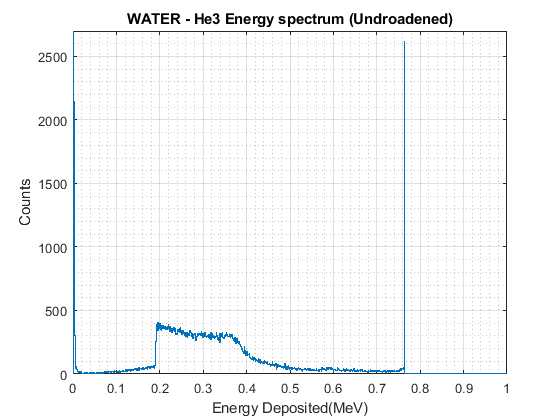Hi, I am trying to simulate a He-3 detector response and I am getting an unexpected spectrum. I am using QGSP_BIC_HP list with G4ThermalNeutrons. My material definitions are:
G4double z3, a2, density2, density3;
G4String name2, symbol2;
G4int ncomponents2;
a2 = 3. * g/mole;
G4Element* elHe3 = new G4Element(name2="Helium3",symbol2= "He",z3= 2., a2);
density2 = 0.00033 * g/cm3;
G4Material* He3_det = new G4Material("He3_det", density2, ncomponents2= 1);
He3_det->AddElement(elHe3, 1);
density3 = 0.00023 * g/cm3;
G4Material* He3_det1 = new G4Material("He3_det1", density3, ncomponents2= 1);
He3_det1->AddElement(elHe3, 1);
Can you please let me know what am I doing wrong.
Thanks,
Sanchit Sharma

The material definition looks OK (it looks like you have defined 2 and 1.5 atm of He3. The spectrum is not necessarily unexpected. It looks like a spectrum in a He3 ionization chamber when there are some gamma rays present and few to no neutrons. What is your geometry and what are your source parameters (particle types(s), number, energy, etc.)?
1 Like
Respected Dr. McFee,
Thanks for your reply. I researched links on the previous forum changed my material as per the guidelines to below:
//// He-3 detector 1 material
G4int protons=2, neutrons=1, nucleons=protons+neutrons;
G4double atomicMass = 3.016*g/mole;
G4Isotope* he3 = new G4Isotope("He3", protons, nucleons, atomicMass);
G4Element* He3 = new G4Element("Helium3", "He3", 1);
He3->AddIsotope(he3, 100*perCent);
G4double pressure = 1.51988*bar;
G4double temperature = 293*kelvin;
G4double molar_constant = CLHEP::Avogadro*CLHEP::k_Boltzmann; //from clhep
G4double Density = (atomicMass*pressure)/(temperature*molar_constant);
G4Material* Helium3 = new G4Material("Helium3", Density, 1, kStateGas, temperature, pressure);
Helium3->AddElement(He3, 100*perCent);
This gave me the correct spectrum (Attached).
I guess my geometry was fine, there an issue with the way I defined my Materials.
Thanks very much!
Regards,
Sanchit Sharma

